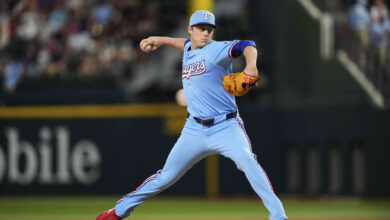
Christopher Morel Top 10 in Swing Speed, Length According to New Statcast Data
Statcast just revealed its bat tracking metrics, which include average swing speed and length, the percentage of swings that are squared up, and even the number of “swords” each player has. Boog Sciambi already noted this during Saturday’s broadcast, but you probably could have guessed anyway that Christopher Morel swings harder and longer — feel free to run with that however you see fit, I like to think of him as anthropomorphic ED medication — than any of his teammates.
Morel’s average bat speed of 76.7 mph — taken from the top 90% of swings — is well ahead of Ian Happ‘s 72.0 mph for the team lead and ranks sixth in MLB. With a swing length of 8.0 feet, Morel’s bat path is just slightly longer than Cody Bellinger‘s 7.8 feet and ties him for eighth overall.
Anyone want to guess who’s got the longest swing in baseball?
That would be Ednel Javier Báez at 8.7 feet, easily outpacing Giancarlo Stanton‘s 8.4 feet. Stanton leads all of baseball with an 80.6 mph average swing speed and he’s by far the most consistent hard swinger out there. A whopping 98.0% of his swings are 75 mph or greater, putting him well ahead of Kyle Schwarber‘s 73.9% rate. Schwarber’s 77.0 mph average swing speed is third overall, just a bit behind Oneil Cruz‘s 77.7 mph. Talk about a couple of guys Cubs fans lament seeing for different reasons.
One very interesting note in all of this is that both Báez and Shohei Ohtani have the exact same average swing speed of 75.4 mph, putting them in a tie for 18th overall. Of course, Ohtani has a much shorter stroke and squares the ball up with greater frequency. But enough about all these players the Cubs don’t have, let’s get back to the the North Side.

You’ll note that Alexander Canario is actually ahead of Morel once we lower the number of swings required for inclusion. You should also note how much lower Canario’s numbers are in terms of balls he squared up or blasted. Morel has made incredible strides with his plate discipline this season, increasing his walk rate to nearly 11% and lowering his strikeout rate by almost 10 points to 21.8% as of this writing.
His swinging strikes are way down mainly because he’s learned to spit on sliders off the plate, a development that should minimize the depth and duration of his slumps. Canario still has plenty of time to learn how to do that as well, though I still think he’s a likely casualty of the outfield glut in the system. Time will tell.
On the other side of the spectrum is Nick Madrigal, whose 65.8 mph swing speed is the lowest on the team and ranks 422nd out of 434 players with at least 25 swings. That’s not much of a surprise, though you might not have guessed that No. 434 is none other than two-time batting champ Luis Arraez at 62.4 mph. According to Statcast, Arraez doesn’t have a single swing of 75 mph this season.
Madrigal has two.
So what does this all mean? Well, that depends on what you’re looking for. Just like any other metrics, it’s important to understand that isolating one specific number in support of a bigger claim would be a mistake because none of this exists in a vacuum. Just like simply throwing hard does not guarantee success, swinging hard is far from a magic bullet. That said, a harder swing generates higher exit velo, which in turn increases the likelihood of getting a hit.
Once we fold in other measurements, we start to get a better idea of the various avenues for either success or failure. Báez was never the best decision-maker at the plate and his loopy swing often fell victim to uncompetitive breaking balls, but he could make up for some of that due to his freakish athletic ability. Now that he’s presumably past the height of his prime, he isn’t twitchy enough to mitigate those issues with his swing.
On the other end of the spectrum, think about how good Arraez needs to be in order to make up for his slower swing. He’s currently tied with William Contreras for seventh in MLB with a 47.6% squared-up rate, though that number could rise if he’s able to get his .308 average closer to his .324 career mark. I’d be very interested to see the swing tracking for last year, when he hit .354 with the Marlins.
Again, none of this is particularly eye-opening and I’d say casual fans can pretty much cast it aside without so much as a second glance. For those who love this stuff like I do, however, it provides a little extra color and allows us to better quantify what we’d really only been able to assume in the past.

